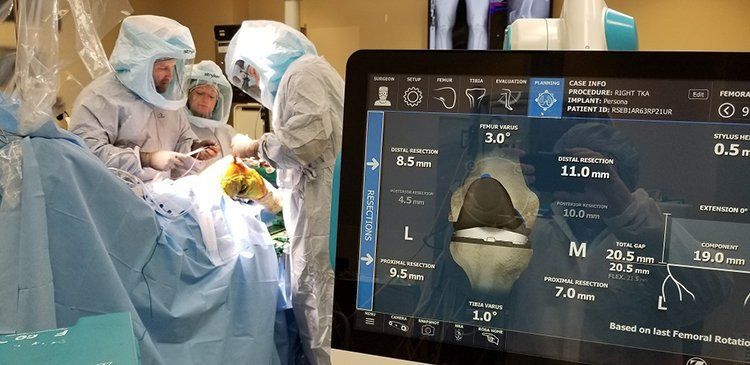KNEE
Robotic Assisted Surgery
Dr du Sart uses robotic assisted knee replacement as it offers the potential to refine and allow for greater precision in this complex operation. He has performed many conventional knee replacements and sees robotic assisted surgery as a significant leap forward in technology and innovation. It allows for greater planning, customisation and precision. Whilst this technology is new, it is paired with proven implants, which should translate to satisfied patients long term.
What is Robotic Assisted Surgery?
Robotics and computer based technology have been widely used in different industries to improve task accuracy and efficiency, and we have seen this in orthopaedic surgery. Whilst Dr du Sart is still in control of the procedure, the robotic technology assists in the bone preparation and placement of the implant. Additional information also allows Dr du Sart to optimally align and balance the knee. The use of robotic assisted knee replacement is becoming more widespread in Australia and internationally. Both Bunbury and Busselton have access to robotic assisted technology.
What happens during robotic assisted surgery?
Dr du Sart uses X-ray to pre-plan the knee replacement, giving a guide on how cuts should be made and the positioning of the implants (prostheses) for optimal results. ‘Virtual knee replacement’ technology enables Dr du Sart to predict outcomes before surgery, this enables improved soft tissue balancing and alignment of the knee. With the use of this information the Dr du Sart uses the robotic arm to guide cuts and position implants as part of the surgical procedure. All other tasks such as skin incision, exposing the knee, trialling and final placement of implant, and closing the incision are completed as per usual.
What kind of implants are used in robotic knee surgery?
The implants (protheses) used in robotic knee surgery are the same as conventional surgery. Rather, the use of robotic technology allows for surgeons to pre-plan size and fit to ensure the best match for your natural knee position. During the operation the robotic arm is used to guide cuts and implant position as well.

What are the advantages?
- Reduction in surgical errors and 'outliers'.
- 3D computer knee mapping resulting in accurate pre operative planning.
- Increased accuracy of prostheses placement compared with conventional knee replacements.
- Accurate bone cuts when compared to conventional knee replacements.
- Ability to accurately balance the knee and gain soft tissue information using robotic software intra operatively.

What are the disadvantages?
Robotic assisted knee surgery is new technology. Although it has been criticised for not having long term data and therefore safety profile, early results of robotic knee replacement surgery are pleasing (Kayani B, Haddad FS, 2019). Robotic surgery overall dates back to the 1980's and robotic assisted joint replacement has become more common since 2008 in the US, expanding globally. As with any new technology it needs to be studied and appropriate training undertaken before use in a clinical setting.
Reference: Kayani B, Haddad FS. Robotic total knee arthroplasty: clinical outcomes and directions for future research. Bone Joint Res. 2019 Nov 2;8(10):438-442. doi: 10.1302/2046-3758.810.BJR-2019-0175. PMID: 31728181; PMCID: PMC6825042.

© All rights reserved
For all appointments and enquiries please contact us on:
Phone: 08 9779 9767
Email: admin@ryandusart.com.au
Address: 6 Higgins St, South Bunbury, 6230
